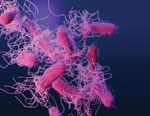Volume 26, Number 12—December 2020
Etymologia
Salmonella
Salmonella [sal′′mo-nel′ә]
Named in honor of Daniel Elmer Salmon, an American veterinary pathologist, Salmonella (Figure) is a genus of motile, gram-negative bacillus, nonspore-forming, aerobic to facultatively anaerobic bacteria of the family Enterobacteriaceae. In 1880, Karl Joseph Eberth was the first to observe Salmonella from specimens of patients with typhoid fever (from the Greek typhōdes [like smoke; delirious]), which was formerly called Eberthella typhosa in his tribute. In 1884, Georg Gaffky successfully isolated this bacillus (later described as Salmonella Typhi) from patients with typhoid fever, confirming Eberth’s findings. Shortly afterward, Salmon and his assistant Theobald Smith, an American bacteriologist, isolated Salmonella Choleraesuis from swine, incorrectly assuming that this germ was the causative agent of hog cholera. Later, Joseph Lignières, a French bacteriologist, proposed the genus name Salmonella in recognition of Salmon’s efforts.
With a complicated taxonomy, the genus Salmonella is currently classified into 2 species (S. enterica and S. bongori), encompassing 2,659 serotypes based on somatic O and H flagellar antigens as specified in the Kauffmann–White–Le Minor scheme. S. enterica is divided into 6 subspecies: enterica, salamae, arizonae, diarizonae, houtenae, and indica. Arguably, this zoonotic pathogen remains one of the most pressing global concerns. It causes a spectrum of diseases in several hosts, and there is much to be learned and deciphered about its continuous evolution.
References
- Dorland’s Illustrated Medical Dictionary. 32nd ed. Philadelphia: Elsevier Saunders; 2012.
- Gossner CM, Le Hello S, de Jong B, Rolfhamre P, Faensen D, Weill FX, et al. Around the world in 1,475 Salmonella geo-serotypes [Another Dimension]. Emerg Infect Dis. 2016;22:1298–302. DOIGoogle Scholar
- Issenhuth-Jeanjean S, Roggentin P, Mikoleit M, Guibourdenche M, de Pinna E, Nair S, et al. Supplement 2008-2010 (no. 48) to the White-Kauffmann-Le Minor scheme. Res Microbiol. 2014;165:526–30. DOIPubMedGoogle Scholar
- Salmon DE. The discovery of the germ of swine-plague. Science. 1884;3:155–8. DOIPubMedGoogle Scholar
- Su LH, Chiu CH. Salmonella: clinical importance and evolution of nomenclature. Chang Gung Med J. 2007;30:210–9.PubMedGoogle Scholar
Figure
Cite This ArticleOriginal Publication Date: November 16, 2020
Related Links
Table of Contents – Volume 26, Number 12—December 2020
| EID Search Options |
|---|
|
|
|
|
|
|

Please use the form below to submit correspondence to the authors or contact them at the following address:
Daniel F. M. Monte, Department of Food and Experimental Nutrition, Faculty of Pharmaceutical Sciences, University of São Paulo, São Paulo-SP 05508-900, Brazil
Top